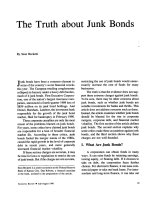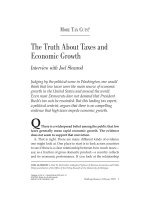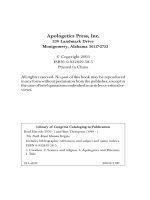The truth about fibonacci trading
Bạn đang xem bản rút gọn của tài liệu. Xem và tải ngay bản đầy đủ của tài liệu tại đây (394.87 KB, 22 trang )
The Truth About Fibonacci Trading
2
The Truth About Fibonacci Trading
The truth about Fibonacci levels is that they are useful (like all trading
indicators). They do not work as a standalone system of trading and
they are certainly not the “holy grail”, but can be a very effective
component of your trading strategy.
But who is Fibonacci and how can he help you with your trading?
Leonardo Fibonacci was a great Italian mathematician who lived in the
thirteenth century who first observed certain ratios of a number series
that are regarded as describing the natural proportions of things in the
universe, including price data. The ratios arise from the following
number series: 1, 2, 3, 5, 8, 13, 21, 34, 55, 89, 144 ……
This series of numbers is derived by starting with 1 followed by 2 and
then adding 1 + 2 to get 3, the third number. Then, adding 2 + 3 to
get 5, the fourth number, and so on.
The ratios are derived by dividing any number in the series by the next
higher number, after 3 the ratio is always 0.625. After 89, it is always
0.618. If you divide any Fibonacci number by the preceding number,
after 2 the number is always 1.6 and after 144 the number is always
1.618. These ratios are referred to as the “golden mean.” Additional
ratios were then derived to create ratio sets as follows:
© 2004 Profits Run, Inc.
Rev 01-20041124
The Truth About Fibonacci Trading
3
Price Retracement Levels
0.236, 0.382, 0.500, 0.618, 0.764
Price Extension Levels
0, 0.382, 0.618, 1.000, 1.382, 1.618
The first set of ratios is used as price retracement levels and is used in
trading as possible support and resistance levels. The reason we have
this expectation is that traders all over the world are watching these
levels and placing buy and sell orders at these levels which becomes a
self-fulfilling expectation.
The second set is used as price extension levels and is used in trading
as possible profit taking levels. Again, traders all over the world are
watching these levels and placing buy and sell orders to take profits at
these levels which becomes a self-fulfilling expectation.
Most good trading software packages include both Fibonacci
Retracement Levels and Price Extension Levels. In order to apply
Fibonacci levels to price charts, it is necessary to identify Swing Highs
and Swing Lows. A Swing High is a short term high bar with at least
two lower highs on both the left and right of the high bar. A Swing
© 2004 Profits Run, Inc.
Rev 01-20041124
The Truth About Fibonacci Trading
4
Low is a short term low bar with at least two higher lows on both the
left and right of the low bar.
Fibonacci Retracement Levels
In an uptrend, the general idea is to go long the market on a
retracement to a Fibonacci support level. The price retracement levels
can be applied to the price bar chart of any market by clicking on a
significant Swing Low and dragging the cursor to the most recent
potential Swing High and clicking there. This will display each of the
Retracement Levels showing both the ratio and corresponding price
level. Let’s take a look at some examples of markets in an uptrend.
The same points made by these examples are equally applicable to
markets in a downtrend.
Example 1: Here we plotted the Fibonacci Retracement Levels by
clicking on the Swing Low at about $71.31 and dragging the cursor to
the Swing High at about $89.83. You can see the resultant levels
plotted by the software. Now the expectation is that if the market
retraces from this high it will find support at one of the Fibonacci
Levels, because traders will be placing buy orders at these levels as
the market pulls back.
© 2004 Profits Run, Inc.
Rev 01-20041124
The Truth About Fibonacci Trading
5
Example 1
Example 1.1
© 2004 Profits Run, Inc.
Rev 01-20041124
The Truth About Fibonacci Trading
6
Example 1.1: Now let’s look at what actually happened after the
Swing High occurred. The market pulled back right through the 0.236
level and continued the next day through the 0.382 level before
finding support. After a few days, the market resumed its upward
move. Clearly buying at the 0.382 level would have been a good short
term trade.
Example 2: Again, the Fibonacci Retracement Levels were plotted on
the chart in the same manner as described in Example 1. Again, we
are looking for the market to retrace from the Swing High and find
support at one of the Fibonacci levels.
Example 2.1: Now let’s look at what actually happened. The market
again pulled back right through the 0.236 level and continued to pull
back until it found temporary support at the 0.50 level (a lot of buyers
at this level). However, once the buying power was exhausted, the
market continued to retrace all the way down to the 0.764 level before
resuming its upward trend. In this case, buying at the 0.764 level
would have been a good short term trade.
© 2004 Profits Run, Inc.
Rev 01-20041124
The Truth About Fibonacci Trading
7
Example 2
Example 2.1
© 2004 Profits Run, Inc.
Rev 01-20041124
The Truth About Fibonacci Trading
8
Example 3: Here’s another example. If the market retraces from the
Swing High, where will it find support?
Example 3
© 2004 Profits Run, Inc.
Rev 01-20041124
The Truth About Fibonacci Trading
9
Example 3.1: Well, in this case the market found support at the 0.50
level. Buying at this level would have been a great trade as the
market gapped up a few days later.
Example 3.1
© 2004 Profits Run, Inc.
Rev 01-20041124
The Truth About Fibonacci Trading
10
Example 4: Here’s one more example.
Example 4
© 2004 Profits Run, Inc.
Rev 01-20041124
The Truth About Fibonacci Trading
11
Example 4.1: Whoops! The market gapped down through all levels
of support and never looked back. A long trade here would have been
a loser or at least an open lose position.
Example 4.1
You can see from these examples that the market often finds at least
temporary support at the Fibonacci Retracement Levels – not always,
but often. It should be apparent that there are a few problems to deal
with here. First, there is no way of knowing which level will provide
support. The 0.236 level seems to provide the weakest support, while
the other levels provide support with approximately the same
frequency. Second, the market will not always resume its uptrend
after finding temporary support, but instead continue to decline below
© 2004 Profits Run, Inc.
Rev 01-20041124
The Truth About Fibonacci Trading
12
the last Swing Low. Thirdly, placement of stops is a challenge – it is
probably best to place stops below the last Swing Low, but this
requires accepting a high level of risk in proportion to the likely profit
potential in the trade. Another problem is determining which Swing
Low to start from in creating the Fibonacci Retracement Levels. One
way is from the last Swing Low as we did in the examples. Another is
from the lowest Swing Low of the past 30 days. The point is, there is
no one right way to do it, and consequently it becomes a guessing
game.
© 2004 Profits Run, Inc.
Rev 01-20041124
The Truth About Fibonacci Trading
13
Fibonacci Price Extension Levels
In an uptrend, the general idea is to take profits on a long trade at a
Fibonacci Price Extension Resistance Level. The Price Extension Levels
can be applied to the price bar chart of any market by clicking on a
significant Swing Low and dragging the cursor to the most recent
Swing High. Then by clicking on the Swing High and back down to the
retracement Swing Low and clicking there. This will display each of the
Extension Levels showing both the ratio and corresponding price level.
Let’s take a look at some examples of markets in an uptrend. The
same points made by these examples are equally applicable to
markets in a downtrend.
Example 5: Here we plotted the Fibonacci Price Extension Levels by
clicking on the Swing Low at about $38.20 and dragged the cursor to
the Swing High at about $47.67 and then down to the retracement
Swing Low. You can see the resultant levels plotted by the software.
Now the expectation is that if the market continues higher it will find
resistance at one of the Fibonacci Levels, because traders will be
placing sell orders at these levels to take profits on there long trades.
Example 5.1: Now let’s look at what actually happened after the
retracement Swing Low occurred. The market rallied making new
highs pausing at the 0.382 level and again at the 1.000 level after a
retracement down it rallied again going right through the 1.382 and
1.618 levels. Taking profits at the 0.382 level would have been
premature, but taking profits at the 1.000 level would have made a
nice trade.
© 2004 Profits Run, Inc.
Rev 01-20041124
The Truth About Fibonacci Trading
14
Example 5
Example 5.1
© 2004 Profits Run, Inc.
Rev 01-20041124
Example 6: Again, the Fibonacci Price Extension Levels were plotted
on the chart in the same manner as described in Example 5. Again,
we are looking for the market to continue higher before finding
resistance at the Fibonacci Levels.
Example 6
The Truth About Fibonacci Trading
16
Example 6.1: Now let’s look at what actually happened. The market
rallied, making new highs and pausing between the 0.382 level and
the 0.618 level, and then continued higher. This up move could well
continue up to at least the 1.000 level. Taking profits at the 0.382
level would have been premature and only time will tell if taking profits
at the 0.618 level was the optimal place to exit the long trade.
Example 6.1
© 2004 Profits Run, Inc.
Rev 01-20041124
The Truth About Fibonacci Trading
17
Example 7: Here’s another example. Will the market continue higher
to one of the Fibonacci Price Extension Levels?
Example 7
© 2004 Profits Run, Inc.
Rev 01-20041124
The Truth About Fibonacci Trading
18
Example 7.1: Well in this case the market found resistance at the
0.382 level which would have been the place to take profits on any
long trades.
Example 7.1
© 2004 Profits Run, Inc.
Rev 01-20041124
The Truth About Fibonacci Trading
19
Example 8: Here’s one more example.
Example 8.1
© 2004 Profits Run, Inc.
Rev 01-20041124
The Truth About Fibonacci Trading
20
Example 8.1: Like the last example, the market found resistance at
the 0.382 level which would have been the place to take profits on any
long trades.
Example 8.1
You can see from these examples that the market often finds at least
temporary resistance at the Fibonacci Extension Levels - not always,
but often. As in the examples of the Retracement Levels, it should be
apparent that there are a few problems to deal with here as well.
First, there is no way of knowing which level will provide resistance.
The 0.382 level was a good level to cover any long trades in two of the
examples, but in the other examples taking profits at that level would
have been premature. Another problem is determining which Swing
© 2004 Profits Run, Inc.
Rev 01-20041124
The Truth About Fibonacci Trading
21
Low to start from in creating the Fibonacci Extension Levels.
One way
is from the last Swing Low as we did in the examples; another is from
the lowest Swing Low of the past 30 days. Again, the point is that
there is no one right way to do it, and consequently it becomes a
guessing game.
Alone, Fibonacci Levels will not make you rich. However, Fibonacci
Levels are definitely useful as part of an effective trading method that
includes other analysis and techniques. You see, the key to an
effective trading system is to integrate a few indicators (not too many)
that are applied in a way that is not obvious to most observers. All
successful traders know it’s how you use and integrate the indicators
(including Fibonacci) that makes the difference. The lesson learned
here is that Fibonacci Levels can be a useful tool, but never enter or
exit a trade based on Fibonacci Levels alone.
Good Trading,
P.S. If you’re really serious about learning how to use what you’ve
learned here along with other indicators, you need to try my trading
course, Instant Profits. Turn the page to find out more.
© 2004 Profits Run, Inc.
Rev 01-20041124
The Truth About Fibonacci Trading
22
"Who Else Wants To Discover The
Trading Secrets That 95% Of All
Traders Don't Even Know Exist...
And Could Give You An Edge That
Most Traders Only Dream About..."
If you want to learn more about using Fibonacci levels along with other indicators,
check out my Instant Profits trading course. I distilled the best of what I learned about
trading into an easy-to-follow trading course that I call “Instant Profits”. The course is
made up of the following parts:
The Instant Profits Manual, including over 40 charts and 50 example trades.
Over 75 minutes of screen capture video tutorials on CD-ROM.
A 90 Minute DVD of my “sneak preview” Instant Profits seminar.
4 trading “blueprints”.
Lifetime customer support – just drop me an e-mail and I’ll answer all your
questions because I want you to be successful!
I’m so confident that Instant Profits will help you that I want you take 90 days to
evaluate it 100% satisfaction guaranteed. If you truly feel that Instant Profits hasn’t
taught you anything about making money in the markets, I’ll give you a full refund.
When you’re ready to order the complete Instant Profits course, just click on the
following link:
/>I worked hard to make Instant Profits easy to understand and easy to apply. I
hope you enjoy everything it has to offer, and I look forward to seeing you become an
owner of the Instant Profits trading course.
Good Trading,
© 2004 Profits Run, Inc.
Rev 01-20041124









